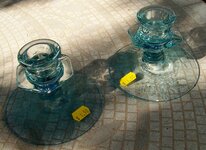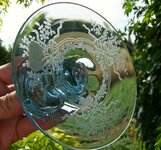tamrock
Gold Member
- Jan 16, 2013
- 15,479
- 31,462
- Detector(s) used
- Bounty Hunter Tracker IV
- Primary Interest:
- All Treasure Hunting
I see a fair amount of clear glass with this etched patterns on them. At times I'll see the peach & cranberry colors and they are always more money in the antique shops. I found these on the latest trip for 3 & change. With these being a aqua-blue color, I'm pretty sure they'll sell for more. I just don't know who made them as there not marked. I looked at these Heisey's, Cambridge and Fostoria glassware and they all have kind of the same look. If any of you out there have some good knowledge on what I may have I'd sure like some opinions. I got you Diggum on my mind as I'm sure I've read some post on what you know on older glass. I'll buy the stuff I see that's marked such as Baccarat, Waterford & Lalique as that's a no brain'r, but this stuff is not what I generally go for. Hope you can tell me who made them and how old they are?... The color and price just said I can't go wrong, or so it seemed to me.





